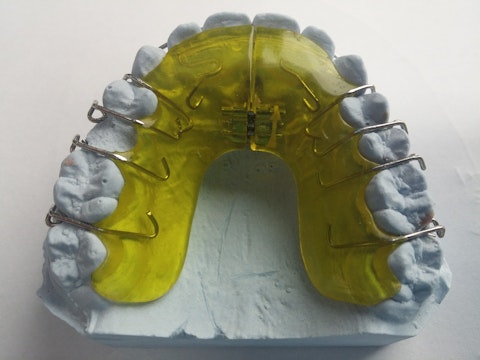In this article, we will be taking a look at the 6 cheaper alternatives to braces for kids and adults. If you do not want to learn about the global orthodontics market, head straight to the 3 Cheaper Alternatives to Braces for Kids and Adults.
In orthodontic care, pursuing a straighter smile doesn’t always have to come with a hefty price tag. For kids and adults seeking to correct dental alignment, there exists a range of cost-effective alternatives to traditional braces. From removable aligners to innovative at-home kits, these options offer affordability without compromising effectiveness. Exploring these cheaper alternatives allows individuals to achieve the confident, radiant smiles they desire without breaking the bank.
Orthodontics Market Overview
The global orthodontics market expansion is attributed to several factors, including technological advancements, increasing aesthetic preferences, and a growing understanding of oral health’s importance. Notably, the market is segmented into instruments and supplies, with clear aligners driving demand in the supplies segment. Some notable advancements include products like Ultima Hook by Ormco Corporation and the Eon Aligner ecosystem by Eon Dental.
The orthodontics market is leading globally in North America due to advanced healthcare facilities and culture emphasizing dental hygiene. In Europe, the market is expected to reach $8.76 billion by 2030, and $8.21 billion in the Asia Pacific region by 2030. The largest market share in 2023 is anticipated to come from the removable braces segment due to factors like malocclusion prevalence and lower costs compared to fixed braces.
In the US, the orthodontics market generated a revenue of USD 3.09 billion in 2022, focusing on clear braces and rising awareness of dental care. Europe accounted for a significant market share in 2022, driven by improved healthcare facilities and technologically advanced products.
Invisalign, a popular transparent aligner system, has contributed significantly to the rising demand for orthodontic supplies globally. Leading companies in the dental products and implants sector include Henry Schein, Inc. (NASDAQ: HSIC), Align Technology, Inc. (NASDAQ: ALGN), and Straumann (SWX: STMN). Henry Schein dominates 28.6% of the dental equipment market share, while Align Technology holds 80-85% of the clear aligner market share due to increased demand for aesthetic orthodontic solutions. Straumann commands about 24% of the global dentistry market share. Align Technology, Inc. (NASDAQ: ALGN) is renowned for its innovative contributions to orthodontics, particularly with the Invisalign system, which is revolutionizing treatment efficiency and patient outcomes. Align Technology, Inc. (NASDAQ: ALGN)’s future strategies focus on digital innovation, with a pledge of $1 million to support orthodontic research in the United States.
Henry Schein, Inc. (NASDAQ: HSIC), a global healthcare leader since 1932, continues prioritizing orthodontics with a strong focus on innovation, education, and social responsibility through its Henry Schein Cares initiative. Embracing the latest trends, the company has introduced Minimum Touch OrthodonticsSM, facilitating virtual visits and supporting practice growth. Looking ahead, upcoming trends emphasize innovation in appliances, treatments, and digital workflows. Regarding financial performance, Q4 2023 witnessed $3.1 billion in net sales, marking a 2.3% increase from the previous year, with predicted sales growth for 2023 ranging from 1% to 3%. Henry Schein, Inc. (NASDAQ: HSIC) has been recognized as one of the World’s Most Ethical Companies for the 13th consecutive year, underscoring its commitment to ethical business practices.
The dental sector, including orthodontics, has shown recovery post-pandemic, with spending on dental services reaching about $113.4 billion in August 2022, representing a 6.4% increase from the previous year. Within the broader dental care industry, the dental implant market is expected to reach $9.62 billion by 2030, with clear aligners also gaining popularity due to growing aesthetic awareness. As smiles are increasingly considered a vital social asset, dental care companies like Align Technology, Inc. are poised for growth.
Bridging Global Disparities in Oral Health Through Dental Innovations
Oral health issues affect a staggering 3.5 billion individuals worldwide, with 2 billion grappling with cavities in permanent teeth and 514 million children enduring cavities in their primary teeth. This challenge is exacerbated by limited access to oral healthcare services, particularly in low- and middle-income countries.
In 2019, Pakistan confronted a severe shortage of dentists, with one available for every 5,000 people in urban areas and none in rural regions like Tharparkar, home to 200,000 individuals. In contrast, Denmark enjoys exemplary dental health despite a relatively low dentist-to-population ratio. Conversely, Ethiopia needs help with a meagre 0.02 dentists per 10,000 people.
The Philippines faces high rates of dental decay, especially among children. Even in nations renowned for advanced healthcare like the United States, there exists a shortage of dentists, with states like California and Missouri notably underserved. Addressing these disparities is paramount in alleviating the global burden of oral diseases.
Dental implants emerge as a resilient solution for individuals encountering challenges related to dentures or bridges. Crafted from metal posts, they provide a steadfast foundation for artificial teeth, reinstating aesthetics and functionality.
Research indicates commendable success rates for dental implants, hovering around 95% in the lower jaw and approximately 90% in the upper jaw, with a slightly lower success rate due to diminished bone density.
In 2023, the cost of dental implants varies based on complexity. For instance, single-tooth implants typically cost $3,000 to $4,500, encompassing examinations, imaging, extractions, if necessary, and crown fabrication. Full-mouth replacements, influenced by CT scans and bone grafts, may cost between $60,000 and $90,000.
Alternative solutions like implant-supported bridges offer cost-effective options for replacing multiple teeth. Full-mouth replacement alternatives encompass individual tooth implants, albeit pricier, and implant-supported dentures such as the All-on-4 method, with costs ranging from $24,000 to $50,000. Location, procedures, and materials utilized significantly influence these costs.
Importance and Impact of Dental Insurance Coverage on Oral Health and Financial Security
Dental insurance coverage plays a pivotal role in ensuring access to oral healthcare, thus impacting both overall wellness and financial security. Dental insurance is widely acknowledged for its role in promoting oral health and overall well-being.
Dental insurance coverage varies across age groups and income levels in the United States. For children aged 0-18, approximately 53% have private dental benefits, 38% have dental benefits through Medicaid or CHIP, and 9% do not have dental benefits. Similarly, for adults aged 19-64, 61.4% have private dental benefits, 15.7% have dental benefits through Medicaid, and 22.8% do not.
As of 2019, 70.3% of persons under 65 had dental insurance in the US. However, challenges persist, with an estimated 68.5 million adults needing dental insurance and additional household members facing potential loss of coverage. Financial aspects related to dental insurance coverage include significant out-of-pocket costs, with 40% of total US spending on dental care being out of pocket in 2014.
Lower-income individuals are particularly affected by cost barriers to accessing dental care. Moreover, many adults covered by Medicaid and Medicare lack comprehensive dental coverage, leading to disparities in access to oral healthcare services. The importance of dental insurance is underscored by its impact on overall health, emotional well-being, and financial benefits such as cost savings.
Efforts to increase broad dental coverage in Medicaid and Medicare are essential to address disparities and ensure optimal oral health outcomes for all individuals. Furthermore, understanding the financial statistics related to dental care is crucial. In 2021, the national average dental plan premium for all commercial products was $29.63 per monthly member, significantly lower than medical premiums. Dental premiums typically cover preventive services at 100%, basic procedures at 80%, and significant procedures at 50%, with an annual limit averaging $1,500 – $2,500.

Our Methodology
For our methodology, we have ranked cheaper alternative options to braces for kids and adults based on their average prices, listing them in ascending order from the most affordable to the most expensive.
Here is our list of the 6 cheaper alternatives to braces for kids and adults.
6. Lingual Braces
Average cost: $7500
Lingual braces offer a discreet and effective orthodontic treatment option by being placed behind the teeth, making them nearly invisible. Their popularity is increasing in the US, particularly among those seeking less noticeable treatment, making them stand among best braces for crowded teeth. They successfully correct various orthodontic issues and have a comparable success rate to traditional braces. However, due to their customized nature and specialized placement, they can be slightly more expensive, ranging from $8,000 to $10,000 for a full treatment course.
5. Invisalign
Average cost: $6000
Invisalign has become a popular alternative to traditional braces due to its inconspicuous nature and comparable cost, ranging from $2,000 to $10,000 in the US. Many dental insurance plans cover Invisalign to the same extent as braces, and payment plans are often available. While both are effective, Invisalign is best for minor orthodontic issues like gaps or crowded teeth. It may be less effective for severe cases but is particularly useful for mild to moderate overbites. Invisalign treatment typically lasts 12 months, shorter than braces, and offers better oral hygiene as aligners are removable, although consistent wear is essential for effectiveness.
4. Ceramic braces
Average cost: $5500
Ceramic braces are a popular and slightly more expensive alternative to traditional metal braces, with costs ranging between 10 and 25 percent higher. Due to their tooth-colored appearance, they provide a discreet option, making them practical for treating various orthodontic issues. Approximately 4 million people in the US wear braces, many opting for cost-effective alternatives like ceramic braces. Regular cleaning and dietary precautions are necessary to maintain their appearance and effectiveness. Ceramic braces cost between $4,000 and $7,000, making them a popular choice for those seeking orthodontic treatment and one of the cheaper alternatives to braces for kids and adults.
Click to see and continue reading the 3 Cheaper Alternatives to Braces for Kids and Adults.
Suggested Articles:
- Top 15 Countries for Dental Tourism.
- 15 Best Dental Insurance Companies Heading into 2024.
- 15 Best Countries for Dental Implants.
Disclosure. None: The 6 Cheaper Alternatives to Braces for Kids and Adults is originally published on Insider Monkey.





